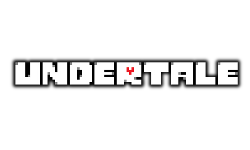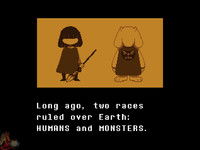|
|

|
PLATFORM
|
PS4
|
BATTLE SYSTEM
|

|
INTERACTION
|

|
ORIGINALITY
|

|
STORY
|

|
MUSIC & SOUND
|

|
VISUALS
|

|
CHALLENGE
|
Moderate
|
COMPLETION TIME
|
Less than 20 Hours
|
|
OVERALL

|
+ Looks and sounds like one of the classics
+ Keeps players' expectations on their toes
- Story works best after multiple playthroughs
- Delights in throwing players off balance
|
Click here for scoring definitions
|
|
|
I wonder at what point during my time with tobyfox's uniquely inspired RPG Undertale it dawned on me that I wasn't as blown away by it as I had been led to believe I would be. Based on everything I'd heard, I should have been in for a magnificent experience that all but redefines what the gold standard for top-notch game development is. Sadly, I count myself among those who've tried to get hooked by the game's unorthodox methods, deliberately opened themselves to every possible angle of indoctrination, and yet still somehow came out the other end having not drunk the Kool Aid. Don't get me wrong: there's plenty to like about the game, but I'd be remiss in pretending that there weren't at least a few times when the humor and satire just fired a bit too far left of center for my tastes.
The story setup is deceptively simple. The game's world is a surprising mix of modern sensibilities injected into an otherwise classic fantasy setting. In its overall mood and atmosphere, Undertale shares more than just a passing resemblance with the SNES cult classic EarthBound. Humans and monsters, having once lived together in peace, now live separate existences with the monsters sealed underground. One day, while exploring a craggy mountainside, a young human boy trips and falls into a crevasse right into the subterranean realm of the monsters. The relatively short length of the game is spent traveling through various areas and settlements of the monster realm, en route to meeting with Asgore, king of the monsters, who has the power to return the boy to his own world. Along the way, he meets several interesting locals, such as the matronly Toriel who takes him under her wing at the outset of the adventure, the skeleton brothers Sans and Papyrus, and the megalomaniacal sentient flower, Flowey. The cast of characters is one of the game's high points, varied and enjoyably written.
What makes the cast of characters stand out in such a positive way also extends to much of the game's enemies, and its unpredictable narrative as a whole. Most players will probably cruise through each of Undertale's environments rather quickly, meaning that enemy variants rarely have the opportunity to outstay their welcome. The constantly-changing rogue's gallery of baddies feels consistently unique, with their own varied combat mechanics. What's more, each has its own distinct personality, with quirks and insecurities that can be exploited during combat by players willing to approach their turn-based combat in a more novel way. By finding out what makes each enemy tick, players can choose to spare their adversaries rather than kill them, though this will result in different combat spoils. Interestingly, this mechanic even extends to the game's bosses, making it possible to attempt a purely pacifist run. Equally as important to the game's personal identity is the way it speeds from one far-flung scenario to the next, keeping players on their toes by subverting their every expectation.
 Bold color palettes paint a picture of a pretty monster realm.
Bold color palettes paint a picture of a pretty monster realm.
|
|
Enemy encounters are presented from a traditional, first-person dungeon crawler point of view. The monsters and player take turns taking swings at each other until one or the other goes down for good. Experience and gold are doled out appropriately, and the game goes on. Sounds pretty straightforward, but in practice, Undertale's combat mechanics are quite unique. Enemy attacks play out in an on-screen rectangular field, where the player's health is represented by a little heart that must be moved around to avoid enemy attacks and projectiles. Each enemy attack is animated in a top-down shooter segment, with bullets, music notes, spiders, laser blasts, teardrops, or whatever best fits the enemy flying around in chaotic patterns. An early vegetable-type enemy, for example, uses an attack that forces the player to dodge a barrage of carrots that drop down for the duration of the attack. Each collision costs health. This system ensures that each enemy features several personalized offensive abilities, and due to the game's quick pacing, there's little repetition from one combat scenario to the next. However, not all players will be willing to buy into an RPG with a shooter-style combat mechanic, and a portion of the game's audience will be immediately and irreconcilably turned off by it.
It's hard to stay under the impression that there's anything traditional about Undertale for very long. Before more than a few minutes have gone by, the player is given a cell phone by Toriel, who wants to be able to keep an eye out for him. While it's not an anachronism per se — the game is set in the vaguely-modern 201X — it's not the kind of conceit one would expect to find in a dungeon crawler emulating the classics of the 16-bit era. Giving the protagonist a piece of modern technology is one of the first instances of how the game sets itself apart from traditional RPG conventions. Setting up traps and puzzles that misfire on the monsters, boss fights that resolve themselves, and an enemy who infiltrates and uses the player's save file against him are only a few examples of Undertale's unique, sometimes fourth-wall-breaking, brand of humor. But there's another side to this coin. By the time the last few dungeons and boss encounters come to pass, the player has been thoroughly conditioned to approach every situation with a cynical eye. So, while an entire late-game dungeon takes the form of a TV broadcast, the surprise has kind of gone by the wayside. The unexpected has become the expected; the game has started to become predictable in its unpredictability, and, in a way, a parody of itself.
 The intro cinematic sets up the simple background story.
The intro cinematic sets up the simple background story.
|
|
At this point, it's clear that Undertale is a lot more than simply a love letter to the 16-bit era of RPGs. However, everything about it from a presentation standpoint seems designed to serve as a callback to those days. Graphics are bold and clean, with sprites seemingly emulating some of the better examples from the late 8-bit to early 16-bit games. The game takes place underground, so naturally there are plenty of blacks and grays in the borders, backgrounds, and combat screens. Environments, on the other hand, pop with pleasingly consistent palettes, and characters are brought to life by subtle, understated animations. Deserving of at least equal praise are the great chiptune compositions featured on the game's soundtrack. Even the game's static intro cinematic gives players a taste of the nostalgic quality of the music. While that's a positive quality in and of itself, the fact that Undertale doesn't deliver the kind of classic experience it continuously reminds the player of ends up working against it rather than in its favor, even if just ever so slightly.
Despite the fact that Undertale didn't tick all my boxes, it was still an enjoyable game. Its visuals and music brought to mind some of my most cherished memories from my formative years, and are top-notch even for games that try to evoke that retro vibe. Its narrative is tongue-in-cheek and consistantly sends surprises the player's way. The game excels at asking players to enjoy it in ways that are incongruous with the traditional way RPGs are designed. Unfortunately, those looking for a more traditional experience may feel short-changed here. The lion's share of the game's character, lore, and emotional impact is experienced by challenging yourself to play the entire game in a completely different fashion. The aforementioned "Pacifist" as well as "Genocide" runs — killing not a single creature or every last one, respectively — reveal many facets of the narrative never even hinted at in the traditional run. As rewarding as it is to find additional nuggets of lore and backstory on a subsequent playthrough, the fact remains that that first go-around, for most, will likely feel lacking in depth, and, while still an enjoyable all-round experience, may not be endearing enough to warrant investing additional time into. For some, a game is over when its credits roll, and if it hasn't made a deep enough impact by then, it may simply be too late.
Review Archives
|









